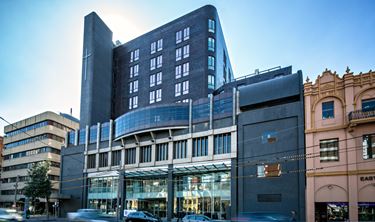Ankle Ligament Surgery
- Home
- Services
- Orthopaedics
- Ankle Orthopaedics
- Ankle Ligament Surgery
What is ankle ligament surgery?
Ankle ligament surgery, sometimes referred to as lateral ankle ligament surgery or reconstruction, is a common medical procedure to treat chronic ankle instability. This condition occurs when the ankle ligaments are damaged, torn or stretched, and no longer work effectively to support the ankle. If you suffer from repeated ankle rolling, and conservative treatment options are no longer effective, your doctor may suggest ankle ligament surgery as the best way to restore support.
The surgical procedure will vary depending upon the extent of the injury but can either be performed arthroscopically using a small camera, or with a small cut on the side of your ankle. If the ligaments are torn, they can be sutured back together. If the ligaments are loosened and weak, they can be shortened and reattached to recreate tension. In some cases, the ligament can be strengthened or replaced with a tendon from another part of your body. The recovery time will depend on the extent of the surgery, with a return to normal activities usually expected by 12 weeks.
Is it right for me?
The ankle has an important job to do in in keeping us stable and supported, but the ankle joint itself has a limited range of motion. If it is subjected to sudden movement or trauma, it is very vulnerable to injury.
Many people tear their ankle ligaments through sport or accidental injury, but not all ankle ligament tears will require surgery. The degree of injury can be determined by imaging such as an MRI or ultrasound.

Other ankle surgeries and procedures
- Ankle Arthroscopy
- Suture Button Ankle Surgery
- Ankle Reconstruction Surgery
- Ankle Fusion
- Ankle Replacement Surgery
- Ankle Fracture Treatment
- Achilles Tendon Surgery
Common ankle conditions
Ankle Ligament Surgery - Patient Journey
Ankle ligament surgery, sometimes referred to as lateral ankle ligament surgery or reconstruction, is a successful medical procedure to treat ankle instability and relieve pain. There are different types of surgery available, and your doctor will discuss with you the extent of your injury and the recommended course of action. The type of surgery required will depend on the severity of the condition. We understand that any kind of medical procedure can be overwhelming, which is why we have multi-disciplinary teams on hand to support you at every stage. We are dedicated to providing a safe and comfortable patient experience at all times.
Deciding where to have your ankle ligament surgery is extremely important, and you should take some time to research your options carefully. Ask your doctor for some recommendations and use the opportunity to find out any relevant information, such as the benefits and risks of ankle ligament surgery, and what results you can expect to see after surgery. Once you are happy with your decision, you can book a consultation appointment with your chosen specialist.
At this appointment your specialist will conduct a thorough medical examination and gather information about your general health. You may be required to have imaging such as an X-Ray or MRI to determine the extent of the injury. Your consultation can also be used to answer any questions you may have about ankle ligament surgery, such as how it will be performed, whether you require minimally invasive or open surgery, and what you can expect your recovery to look like. You can also discuss what the surgery may cost, and what the outcome might be without surgery. Once your doctor has advised on a course of treatment, you can begin to prepare for your hospital admission and surgery.
Your doctor will talk to you about what you need to do to prepare for ankle ligament surgery. This may include taking or stopping any prescribed medications such as blood thinners. As your mobility will be limited after the operation, you may want to make some preparations at home and organise some help with daily tasks until you are cleared to bear weight and drive. When you arrive at hospital, our team will make sure you are comfortable, and your ankle orthopaedic specialist will visit you to answer any final questions.
On the day of your ankle ligament surgery, it is important to follow your surgeon’s fasting advice to prevent any delays to your procedure. Once at hospital, your anaesthetist will talk to you about the type of anaesthetic to be used and the procedure involved. The extent of the operation can vary by patient and will depend on the procedure involved. In milder cases, the ligaments may need to be repaired or shortened. In more severe cases where the ankle ligament has pulled away from the bone, it must be reattached. In some cases, a tendon is used from another part of the body such as the hamstring to strengthen the ankle. The operation itself can take up to 2 hours and you are usually discharged the same day.
Once you have left hospital, it’s important to keep your leg elevated to help reduce the swelling and relieve painful symptoms. The hospital will provide you with crutches to get around at home, and you will be advised to keep the weight off your ankle. You can read more about what to expect during recovery on our ankle ligament surgery recovery page. When you are discharged, we will supply a personalised rehabilitation program including guidance on how to care for your ankle, your follow-up appointments and a physiotherapy exercise program. The recovery time is different for all patients and will depend on the extent of the surgery.
The rehabilitation program after ankle ligament surgery will vary by patient as the type of procedure can be very different depending on the grade of injury. Your foot will spend some weeks in a cast or special orthopaedic boot to protect the ankle while it heals. It may be up to 6 weeks before your doctor advises any weight-bearing. Physiotherapy will usually begin around 2-3 weeks after surgery with a full return to daily activities expected with 4-6 months.
Ankle ligament surgery FAQs
Contact us today for a specialist consultation and learn more about how you could benefit from ankle ligament surgery.
Find a hospital with orthopaedic services
Our Hospitals




